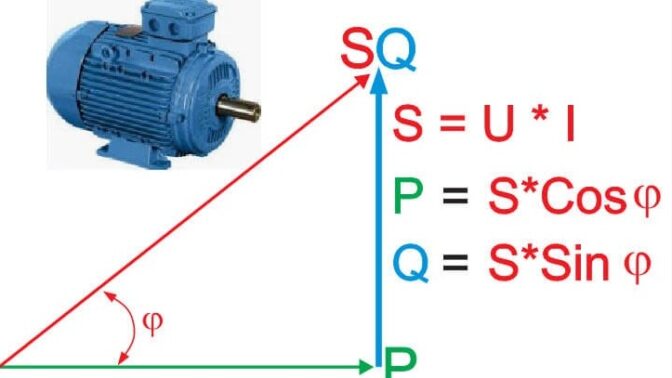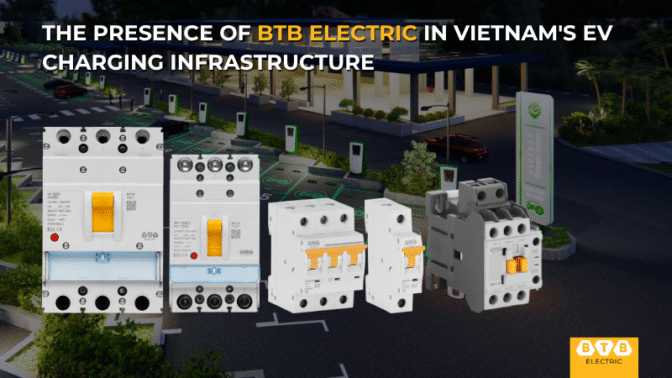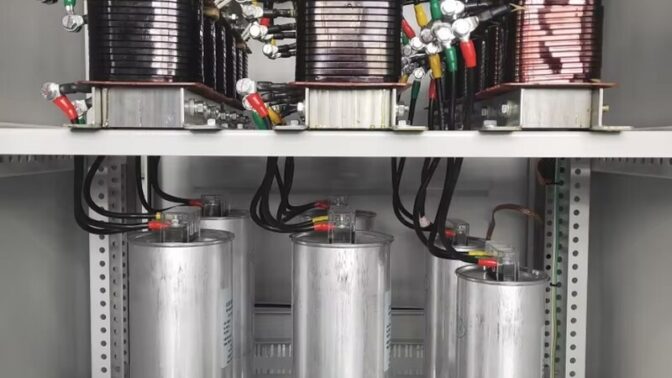24-12-2025
What is ELCB? Principle of operation and installation
ELCB is a block-type circuit breaker used in residential and industrial power as an automatic anti-shock circuit breaker, anti-power leakage and line overload. ELCB has superior structure and features compared to traditional CB series. Specifically about the ELCB concept, the working principle and practical application of this device will be included in the following summary from BTB Electric.
ELCB Concept and Structure
ELCB (Earth Leakage Circuit Breaker) is also known as an earth leakage circuit breaker or block anti-shock breaker. The ELCB has the same characteristics and functions as a ground protection relay with the ability to measure ground leakage current, assess hazard levels, and shut off power if that current exceeds the cut-off limit.

Anti-recoil ELCB can be considered a combination of RCCB with leakage current detection and MCCB with overload resistance. Therefore, installing an ELCB will greatly increase the safety for electricity users, avoiding the risk of electric shock, especially in rainy and humid weather.
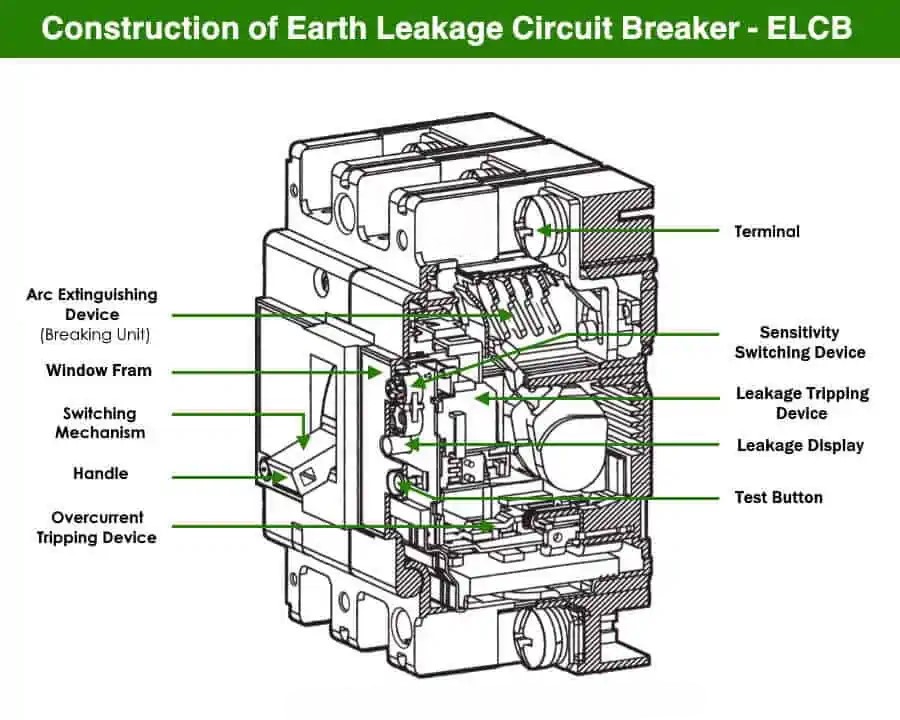
The ELCB can adjust the connection circuit, the device will be grounded through the leakage circuit breaker. The two ground terminals of the appliance are linked: 1 connector to the CPC wire (grounding circuit protection wire), 1 connector to the grounding rod. As a result, the inductor of the ELCB is grounded through the circuit.
ELCB's Operating Principle
ELCB is available in two versions, voltage ELCB and current ELCB. Voltage ELCB is the old ELCB version and current ELCB is the modern version with the same features as RCBO or RCCB. On the other hand, the ELCB also acts as an MCCB with overload resistance. A sudden high current exceeding the rated current limit In will cause the ELCB to interrupt the circuit. Thanks to this feature, ELCB can replace MCCB in industrial electrical systems, as well as be applied as an anti-shock breaker for many residential appliances.
Working Principle of ELCB Current
The working principle of the current ELCB is based on the difference in the outgoing and outgoing currents to detect this difference value on the load side. Inside the ELCB there is a toroidal magnetic core that passes through the two conductors (phase wire and neutral wire) passing through. The induction wire is wound around the magnetic core to measure the difference, the two wires are wound equally to ensure there is no continuous magnetic deviation.
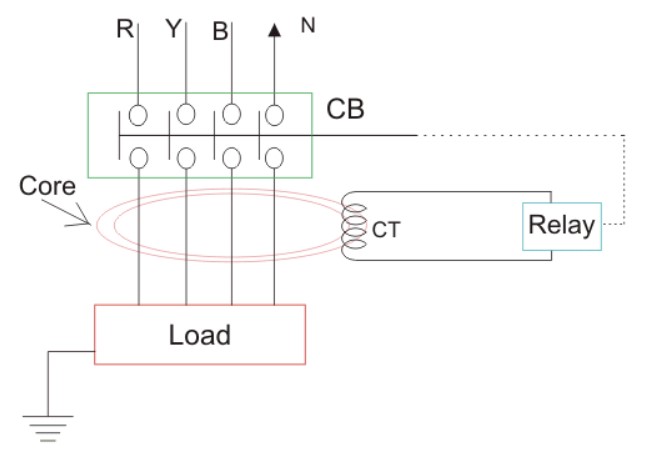
When there is any soil leakage incident, residual current will arise due to the difference between the direction of the outgoing and returning current. When this residual current exceeds the design limit, the electromagnetic relay in the ELCB will disconnect the power supply to prevent this current from spreading to electrical equipment that poses a danger to the user.
Working Principle of Voltage ELCB
The operating principle of voltage ELCB is relatively simple. One end of the relay coil in the ELCB is connected to the metal body of the connection device to protect against ground leakage, the other end is connected directly to the ground wire.

If the insulation is no longer available or the live phase wire touches the metal body of the connection device, a voltage difference will appear between the ground wire and the terminal of the wire connection to the metal body. The differential current portion will run through the relay coil in the ELCB. The current voltage when exceeding the allowable limit will be large enough to trigger the circuit breaker relay. This current difference phenomenon is also known as soil leakage current and is also the origin of the name ELCB.
Because of its rather specific operating principle, the voltage ELCB can only detect and protect the equipment or connection circuit (detected in the load wire) but cannot be detected on other equipment or areas in the electrical system.
Common ELCB Types
The ELCB classification is quite similar to the classification for other electrical CB series with factors such as phase number, polar number or leakage current rating.
Classified by phase number and pole number, ELCB has:
- 3-phase 3-pole ELCB: operates in a 3-phase electrical system with 3 pairs of poles for 3 phase wires.
- ELCB 3 phase 4 poles: operating in a 3-phase electrical system, there are 3 pairs of L poles for 3 phase wires and 1 pair of N poles for neutral wires.
In terms of leakage flow level parameters, ELCB is classified into many levels with the lowest being 30mA and then 100mA, 300mA, 500mA and the highest being 1000mA. The 30mA ELCB level is used for installation in residential electricity with electrical appliances such as water heaters. While the maximum ELCB level of 1000mA used in industrial power has a large leakage current system or electrical protection against fire incidents.
Comparison of ELCB and RCBO
ELCB and RCBO are both anti-recoil breaker lines with built-in overload protection and have some of the following differences:
In terms of function, RCBO has additional electrical protection and overload protection functions. In terms of operating principle, ELCB measures leakage and circuit breaker currents by recognizing the difference between outgoing and returning currents. The RCBO detects residual current and cuts off power when the reference value is exceeded.

In terms of operating system, breaker ELCB is suitable for low-voltage power grids equipped with ground wires. Aptomat RCBO is used for lines with AC frequency of 50Hz or 60Hz, with a voltage of 220V for 1-phase type, 2-phase and 380V for 3-phase type. RCBOs are designed for overcurrent (overload and short circuit) protection and electric shock protection.
For details about the differences between these 2 devices and their application in practice, you can follow the comparison of ELCB and RCBO from BTB Electric.
Notes when installing ELCB
When choosing to install an ELCB in an electrical circuit, you need to pay attention to the circuit breaker leakage current level parameter. The lower this parameter, the more sensitive the ELCB is and easier to cut off the power. For example, in a family under normal conditions, installing a 30mA ELCB is suitable. However, if the mounting environment is frequently humid and the leakage current does not pose a danger to humans, it may be possible to consider increasing the leakage current level.
Besides, if your electrical system is divided into many levels and branches, it is essential to install a total ELCB. The In current strength parameter of this ELCB needs to be equivalent to a total CB. Along with that, the breaker ELCB needs to have a high leakage current cut-off level, equal to the total leakage current of the rear branches to avoid disconnecting the entire system when there is a power detection problem in the sub-branches. Some appliances placed in humid environments such as washing machines and water heaters can cause large leakage currents, resulting in high total leakage currents. For example, you choose a total ELCB with a safe leakage current of 500mA, respectively, branch ELCBs have a leakage current level of 100mA – 300mA and the ELCB for the device alone is 30mA.
ELCB Installation Instructions for Water Heaters
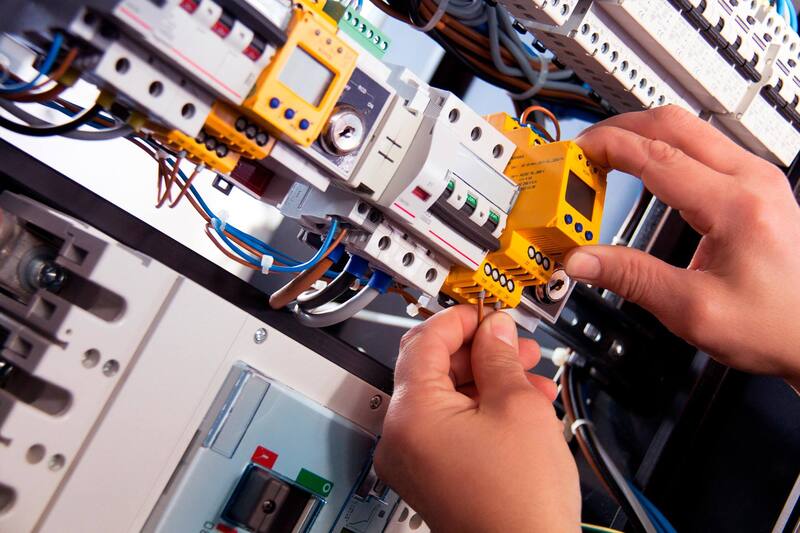
Then, proceed to install the ELCB for the water heater with the following steps:
- Step 1 – Choose an installation location: Most ELCB heaters are installed next to the place where the bathroom electric switch is located, right next to the door. This position is both convenient to operate and does not worry about mold affecting the quality of ELCB. Alternatively, you can choose to install the ELCB at the central electrical box of the corresponding floor.
- Step 2 – Disconnect main/branch power supply: Make sure the power supply leading to the ELCB installation area is disconnected and cannot be switched on while you are installing. After the power is disconnected, it is recommended to check the installation location with an electrical tester.
- Step 3 – Attach the ELCB: Bolt the ELCB into the installation wall location or insert the ELCB into the electrical box chute. After attaching the ELCB, you need to check the mounting direction and sturdiness again.
- Step 4 – Wire the ELCB: Route the phase wires (usually red) one at a time to the L terminals of the ELCB. Pay attention to the right direction of electricity in and out. Then wire the neutral wire (usually blue or black) to the N terminal of the ELCB.
- Step 5 – Check: After the wiring is complete, you check the installation location and wiring the ELCB again. Then close the mains again, check for electrical leakage and try to turn on the breaker ELCB to use the water heater.
Select ELCB from BTB Electric
ELCB BTB Electric is an equipment used in electrical cabinet systems, substations at power companies and industrial factories across the country. This is a high-quality leakage circuit breaker certified by IEC/EN 60947-2 and certified by Dekra, bearing the trademark KEMA – KEUR. The advantages of this CB series are:
- Ability to adjust the normative design line, flexibly in the range of 40% – 100% of the normative line
- Equipped with an LED overload indicator. The light illuminates continuously when the load current is between 40% and 100% and flashes when the load current exceeds the rated setting line of > 5%.
- Wide range of leakage current levels from 30mA to 1000mA.
- Highly recyclable with more than 90% of components reusable.
ELCB included components: auxiliary switch (AUX); alarm switch (ALT); shunt trip breaker (SHT); low-voltage protection coil (UVT); motor (MOT); lever; racks.

We are proud to offer a product line of high-quality, versatile switchgear that is versatile and satisfies all partners. Refer to other products from BTB Electric at: https://btb-electric.com/
Some questions about ELCB
Question 1: Does ELCB have overload protection?
Answer: ELCB has the function of current overload protection. When the amperage on the circuit crosses the setting threshold of the ELCB, it causes a thermal effect, opening the contacts inside the ELCB and interrupting the current going to the load.
Question 2: What is the Test button on ELCB for?
Answer: The test button on the ELCB is used to test the resistance to shock. In the ELCB closed state (lever facing upwards), when the test button is pressed if the lever jumps down (ELCB circuit breaker) i.e. the anti-shock function is active.
Question 3: How to choose ELCB for a water heater?
Answer: The water heater is a device used daily in the family, so the first thing when choosing an ELCB for a water heater is to choose a leakage current level of 30mA (safe leakage current ceiling for humans). Then it is necessary to select an ELCB with a current intensity compatible with the capacity of the water heater. For example, a 30l water heater with a capacity of 2500W should use ELCB 16A 30mA.

